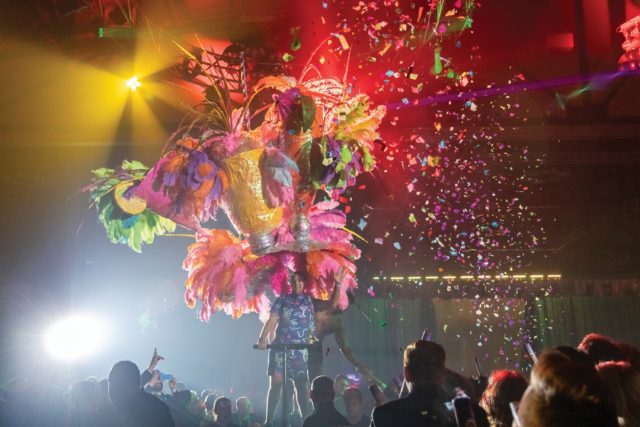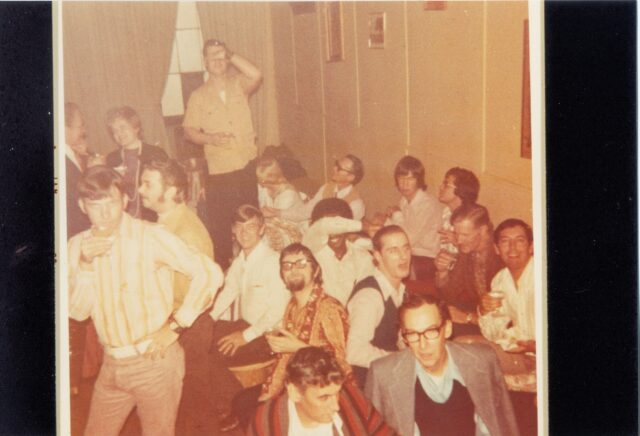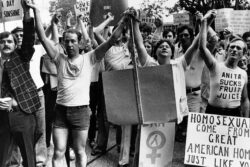LGBTQ+ Rights Movement in Louisiana
Queer people have long been part of Louisiana’s history, but the political movement for LGBTQ+ rights emerged slowly in the late twentieth century.

AP Photo
Gay rights protestors march through a French Quarter street to protest singer Anita Bryant performing in New Orleans on June 18, 1977.
Residents who would now identify as “queer” have existed in Louisiana since before its founding, but the political movement for lesbian, gay, bisexual, transgender, and queer (LGBTQ) rights emerged slowly throughout the late twentieth century, as compared to other American states with sizable queer populations. This delay was largely a holdover of French- and Creole-influenced traditions creating an unspoken “social compact” wherein non-heterosexual behavior could be accommodated so long as it remained apolitical and private.
This older system of “open secrets” conflicted with an LGBTQ+ rights movement attempting to organize publicly. Into the 1970s “gay politics” was often considered a dangerous phrase in Louisiana society, where same-sex acts had been illegal since 1805. National movements such as Gay Liberation experienced early rejection into the 1960s, but a grassroots political awakening did occur in 1977, when anti-homosexual spokesperson and singer Anita Bryant visited New Orleans and inspired a massive gay protest. The 1980 founding of the Louisiana Lesbian and Gay Political Action Caucus, popularly known as LAGPAC, gave the state its first sustainable gay political group.
In 1991 LAGPAC led a coalition that secured the passage of a nondiscrimination ordinance protecting homosexuals in New Orleans. Statewide efforts, however, would be largely stymied with the exception of a hate-crimes law protecting gays and lesbians, which passed in 1997. It took federal decriminalization in 2003, through the US Supreme Court’s landmark decision in Lawrence v. Texas, to nullify criminal statutes against same-sex acts in Louisiana.
Queer Terms
Prior to World War II, “homosexuality,” as it flourished within the state’s cultural heritage, lacked a defining framework or even an agreed-upon language. Even among two-spirit traditions observed in indigenous tribes such as the Choctaw and Chickasaw in the 1700s, same-sex behavior was considered more verb than noun, an activity performed in private rather than an all-encompassing identity or characteristic.
Euphemistic words developed to offer protection for “bachelors,” “spinsters,” and “companions,” who embraced deniability in the face of expanding legal codes punishing non-heterosexual behavior. For example, starting in the late 1800s, some New Orleans aristocrats found same-sex romance through the “Uptown Marriage”—an economic partnership between two opposite-sex spouses wherein one partner was permitted to engage in same-sex affairs on the side. The laissez-faire attitude of the state, epitomized by Carnival season, also allowed for such broad types as the fashionable “dandy” aristocrat or queer celebrities such as pianist Tony Jackson or playwright Tennessee Williams.
It wasn’t until World War II, when draft boards identified homosexuality as a disqualifying “4-F” characteristic, that the medical term “homosexual” entered common usage. Likewise, Louisianans rejected the words “gay” and “lesbian” into the 1970s, as their use of either was considered an act of advocacy for then-criminal behavior. Newspapers like the Advocate in Baton Rouge and the Times-Picayune in New Orleans policed such words to keep them out of print. Local terms for gender minorities, which evolved from “cross-dresser” in the 1960s to “transsexual” in the late 1970s to the contemporary “transgender,” experienced similar resistance. Lastly, the reclaimed word “queer,” which incorporates all sexual and gender minorities past and present into a common identifier, was not embraced until the twenty-first century.
Criminal Code
As secrecy governed same-sex behavior for several centuries, Louisiana’s earliest gay history mostly exists in the form of criminal records for flagrant offenses. One of the first recorded instances of homosexuality in Louisiana dates to 1724. In that year, a ship captain named Beauchamp of the Bellone was discovered having a sexual affair with his cabin boy in the port of New Orleans, and dismayed authorities attempted to separate the lovers. Although moral hostility endured, Louisiana passed no laws against same-sex acts until 1805. Drawing upon English common law shortly after the Louisiana Purchase of 1803, the new American government outlawed “the detestable and abominable crime against nature,” with a mandatory penalty of life imprisonment with hard labor.
Subsequent revisions to the penal code in the twentieth century reduced the mandatory penalty—by 1942 the minimum sentence was two years in prison with hard labor optional—but the stigma surrounding same-sex acts rendered non-heterosexuals a criminal class. Heterosexual citizens who attacked or robbed sex “deviates” (a common midcentury term used by police and public officials to describe homosexuals) were rarely charged or convicted, as such victims were considered to be outside the law’s protection. For example, in 1958 a Mexican tour guide named Fernando Rios was lured from a Bourbon Street gay bar and then ambushed and beaten to death. His three confessed attackers, undergraduates from nearby Tulane University, were found not guilty by a jury because Rios had allegedly made an “indecent advance.”
Local harassment ordinances to “drive out the deviates” expanded amid the anti-communist hysteria following World War II, countering a postwar population boom that occurred when a generation of gay men who’d served in foreign conflicts moved to cities like New Orleans. These ordinances mandated the firing of “immoral workers,” the arrest of patrons imbibing in an immoral establishment, the eviction of gay tenants, and the seizure of property. Gays and lesbians could also be arrested for dancing in a close embrace or for “obstruction of free passage,” legalese for blocking a sidewalk.
Moreover, an arrest for any of these offenses could result in unwanted publicity for the accused when names, addresses, and associated charges were published in popular crime sections of newspapers like the Advocate or the Times-Picayune. Such exposure often resulted in the accused being immediately terminated from employment and blacklisted from community circles.
Enforcing the System
Mid-twentieth-century concepts such as “Pride” and public “out-ness” challenged Louisiana’s system of “open secrets” and provoked backlash. Straight authorities often utilized the brute force of police to maintain order by conducting raids or entrapment operations whenever a queer population was deemed too public or brazen. For example, in 1962, when the state’s first gay Mardi Gras organization, the Krewe of Yuga, held a clandestine drag ball in Metairie, Jefferson Parish police raided the festivities and arrested 96 men for “disturbing the peace.”
Neither national homophile organizations—part of an early homosexual-rights movement that deemphasized sex using the Greek words homo and phile, meaning “same love”—in the 1950s and 1960s nor the Gay Liberation movement, galvanized by the 1969 Stonewall Uprising in New York City, found eager recruits among Louisiana’s gay aristocrats or its gay working class, both of which feared exposure. For example, a New Orleans contingent of the Gay Liberation Front (GLF), founded in 1970 by working-class gays and lesbians, picketed City Hall and negotiated a temporary halt to police sting operations. Despite this success they failed to attract new membership and dissolved by 1972.
The Building Ferment
Following World War II a fledgling gay subculture arose in New Orleans that gave the city the nickname “Queer Capital of the South.” Popular gay bars such as Dixie’s Bar of Music and Café Lafitte in Exile offered well-known anchors for queer life on Bourbon Street. Starting in 1949 gay men began to meet for brunch on Shrove Monday in the French Quarter for an event that came to be called the Fat Monday Luncheon. Similarly, in 1953 a mysterious gay gentleman’s group called the Steamboat Club was established.
Membership in private groups, however, was strictly guarded, and access to popular gay bars often required introductions, so as to assure that a new patron was not an undercover vice officer or a violent assailant. It must also be noted that such groups and bars were segregated by gender and race into the 1980s. Gay black men—isolated threefold by the gay white community, the straight white community, and the straight black community—congregated in clandestine clubs such as Fourth World, which met in private homes. Sadly, little record survives of these societies.
A small Daughters of Bilitis chapter formed in New Orleans in 1960, reflecting the development of an early lesbian consciousness in the state, while gay white men founded Mardi Gras krewes such as Yuga (1958), Petronius (1961), Amon-Ra (1965), and Armeinius (1968). The Krewe of Apollo, founded in New Orleans in 1969, developed sister branches in Baton Rouge, Lafayette, and Shreveport. These krewes, which hosted annual drag balls, spurned political action unless goaded by authorities.
For example, in 1969 Orleans Parish District Attorney Jim Garrison outed an elite businessman named Clay Shaw during a notorious show trial. Garrison bizarrely accused Shaw of conspiring to assassinate President John F. Kennedy as part of a “homosexual thrill killing,” and a jury acquitted Shaw of all charges. In response, a consortium of gay krewes met in 1972 with a rival candidate for district attorney named Harry Connick Sr., who went on to unseat Garrison. Notably these same krewes did not support Barbara Scott, a trailblazing feminist lesbian, with the same enthusiasm when she ran as a Republican candidate for the Louisiana State Legislature in 1971. Though Scott represented the first openly queer Louisianan to seek elected office, her gender placed her across a divide that gay elites of the time hesitated to cross.
Breakthrough
It was the 1973 Up Stairs Lounge fire, an internationally reported incident at a New Orleans gay bar resulting in 32 deaths, that first forced Louisiana to acknowledge a large queer population, estimated at 60,000 of New Orleans’s then 600,000 residents. Following the fire, a groundbreaking six-part series of Times-Picayune articles put a spotlight on New Orleans’s queer community. The first article of the series, entitled “No Mardi Gras Magic: Gay Community Surfaces in Tragedy,” emphasized how the city’s queer population “does not magically appear on Mardi Gras” but exists year-round. But the revelation that queer people were a part of Louisiana life, a revelation brought on by the deadliest fire on record in city history, provoked reactions ranging from hostility to discomfort.
Ensuing political action to promote the tragedy, organized by national gay leaders such as Morty Manford of the Gay Activists Alliance of New York City, aroused bitterness from local gays such as Up Stairs Lounge owner Phil Esteve. “I do not want my bar or this tragedy to be used to further any of their causes,” Esteve told a reporter. Memories of locals mocking the fire victims, in addition to the published photograph of the corpse of Up Stairs Lounge victim Reverend Bill Larson, instilled a statewide fear that those who outed themselves would face violent consequences. Such anxieties persisted in the “Queer Capital” for years. For example, a queer intellectual group founded in 1976 as the Gertrude Stein Democratic Club quickly changed its name. “They decided that was too political sounding to get people involved,” explained New Orleans historian Roberts Batson. The group became the Gertrude Stein Society.
The political dams broke in June 1977 when anti-homosexual spokesperson and singer Anita Bryant visited New Orleans to give a concert at the Municipal Auditorium. Riled by her message that homosexuals sought not equal rights but the right to sexually abuse children, eight local gay and lesbian organizations united to found the Human Equal Rights for Everyone (HERE) coalition. All but two of New Orleans’s gay krewes, plus the New Orleans chapter of the National Organization for Women, joined HERE to oppose Bryant’s visit. On Sunday, June 18, 1977, more than 2,500 anti-Bryant demonstrators rallied in Jackson Square and marched to the Municipal Auditorium chanting, “Out of the closets and into the streets!” The Times-Picayune called it the biggest gay rights protest in New Orleans history. Bryant’s homophobia would spur a generation of queer political recruitment in Louisiana, with New Orleans as its central hub.
A Growing Movement
In 1978 a New Orleans group called the Pink Triangle Alliance hosted the state’s first Gay Pride rally, aligning Louisiana with the national “Pride” tradition born out of the Stonewall Uprising. By 1980 a circle of queer activists founded the Louisiana Lesbian and Gay Political Action Caucus, or LAGPAC, with the stated purpose of working “through the political system to promote full equality and civil rights for all lesbians and gay men.”
A gay activist named Blanchard “Skip” Ward became LAGPAC’s point man in North Louisiana, and Ward also co-founded a gay humanistic group in Shreveport called Le Beau Monde. LAGPAC’s creation of a State Gay Conference in 1981 led to coordination with gay affiliate groups and sparked a pan-Louisianan alliance with the goal of repealing criminal statutes against sexual minorities and securing nondiscrimination legislation to protect gays and lesbians. Political contacts in Acadiana, Alexandria, Baton Rouge, Monroe, and Shreveport soon manifested and organized, and Shreveport was hosting Gay Pride events by 1983.
In South Louisiana, New Orleans activists advanced a nondiscrimination ordinance protecting homosexual residents in 1984 and 1986, although both efforts failed to garner enough votes to pass in the city council. (Passage of an ordinance would not occur until the next decade.) As the 1980s progressed the fight against AIDS also gained urgency, and a gay and lesbian coalition called the N.O./AIDS Task Force filed articles of incorporation in June 1983. By 1989 gay New Orleans elites, previously aligned with the system of “open secrets,” organized the Forum for Equality for more open engagement with AIDS and civil rights causes.
One could hardly address LGBTQ+ rights in this era without acknowledging the AIDS crisis. For example, while running for Louisiana State House in 1991 as an openly gay candidate, New Orleans native and Black civil rights advocate Larry Bagneris simultaneously lobbied for the N.O./AIDS Task Force. In Baton Rouge state legislators sponsored and then killed more than one hundred fifty AIDS-related bills proposed to provide funding for the care and hospitalization of people with AIDS.

Jacque Rowe celebrates at Krewe of Apollo de Lafayette, the state’s longest-running gay Mardi Gras krewe. Photo by Johnathon Silver Ahhee.
Queer Victories
In 1991, after eleven years of lobbying, LAGPAC and the Forum for Equality led a coalition that secured the passage of a nondiscrimination ordinance protecting homosexuals in New Orleans. This ordinance would expand to protect transgender residents in 1998.
In 1997, after sustained petitioning on the part of LAGPAC and a broader organization called the Louisiana Coalition for Individual Dignity, Louisiana became the first state in the Deep South to pass a hate-crimes bill that included sexual orientation. Soon afterward the state’s tilt toward religious conservatism made further LGBTQ+ victories untenable. In 2016 a controversial Blue Lives Matter amendment expanded the hate-crimes statute, originally enacted to protect minority groups from acts of violence, to also prevent the targeting of law enforcement officers.
Louisiana’s nearly two-hundred-year-old law prohibiting private same-sex acts stood until 2003, when the US Supreme Court struck down sodomy laws nationwide through the landmark case Lawrence v. Texas. Since then state lawmakers have declined to repeal the statute, and its presence on the books has resulted in accidental charges as recently as 2013. Similarly, in 2020 the US Supreme Court extended employment protection clauses of the 1964 Civil Rights Act to sexual and gender minorities in Louisiana through the groundbreaking decision Bostock v. Clayton County; its implementation is ongoing.

